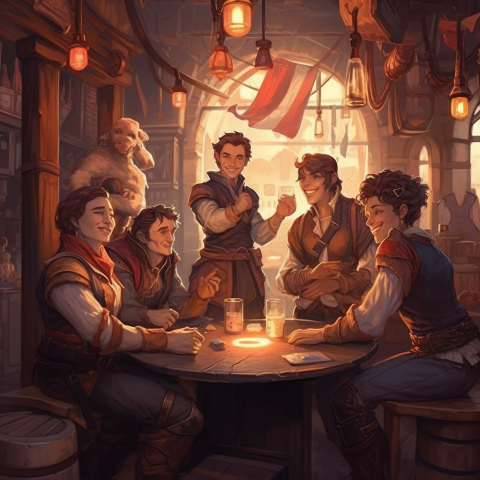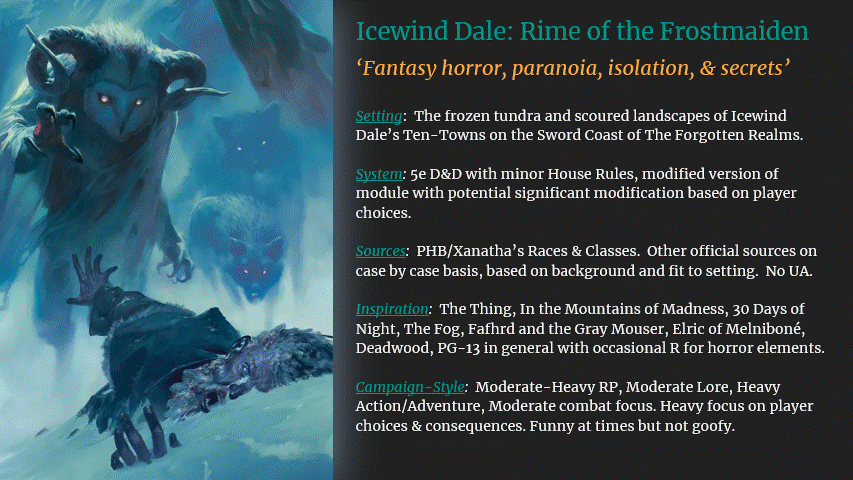Launching a new Dungeons & Dragons campaign is no small feat. It requires not only the arduous task of finding players, but also identifying those who are the perfect fit for your envisioned adventure. Even before delving into character backgrounds, safety tools, or other vital session zero elements, a Dungeon Master’s first hurdle is convincing potential players to invest their precious time and energy into the unfolding saga. This initial step bears striking similarity to pitching a fresh product or service. Just as entrepreneurs entice investors with the promise of innovation and value, DMs need to captivate potential players with a compelling campaign concept. Enter the Pitch Deck - a tool commonly used in the business world, but equally potent in setting the stage for a thrilling D&D campaign.
Indeed, a Pitch Deck isn’t mandatory. You could create a written summary instead. The advantage of a deck, however, is its brevity and focus on essentials. Regardless of format, the aim stays the same. We’ll conclude with a template to help you craft your own pitch, be it a Deck or a Summary.

What is a Pitch Deck?
A pitch deck is a short presentation that shows off your unique game idea. It gives people a sneak peek into your game’s style, story, changes to rules, schedule, and other key parts that make your game special.
Although your D&D game doesn’t need money from investors, a pitch deck is still very useful. It helps you get people excited to play and willing to spend their valuable time on your game.
Creating a D&D Campaign Pitch Deck
The contents of a pitch deck can vary based on firm a concept the DM has for the game they’re looking to run, but it often includes several key elements. First, it establishes the premise, tone, and style of the game, providing relevant examples. Second, it delves into how the party will interact with each other and their surrounding world. Third, it outlines how the game will engage with its mechanics. Finally, it sets certain baseline boundaries and expected norms within the group, laying the groundwork for future collaboration or safety tools.
The Campaign Pitch Summary
The essence of your pitch lies in just one slide - this is it! Captivating your audience involves inciting curiosity for more, so focus on broad strokes and highlights. Tease the plot, evoke the action, and convey the tone of the game. If the players you’re pitching to aren’t familiar with each other, share a few insights about your DMing style, the humor at the table, and the particular rules you’re implementing. Save the details for follow-up questions or Session Zero. Your primary goal is to pique the players’ interest and steer their thinking in the right direction from the start.
Here’s what I recommend:
- Campaign Title and Tagline: Consider examples like “Rime of the Frostmaiden: A chilling struggle for survival in the heart of fantasy horror” or “Trouble on the Triboar Trail: Frontier justice meets rugged survival in the untamed Sword Mountains.”
- Setting: Include a brief mention of the setting, landscape, travel logistics, or how players will interact with the world.
- System: Outline the system, edition, any specific versions, and sources the game will use. Example: “5e D&D, minor house rules apply. Core books, Xanathar’s, & Tasha’s acceptable. No Unearthed Arcana, please.”
- Inspiration: Reference a few films, books, or other media that capture the campaign’s intended ambiance. If relevant, consider including a film-like rating for the campaign.
- Campaign Style: Indicate how Roleplaying, Lore, Action, and Combat will factor into the campaign. You might also want to mention the degree of consequence in the game. Adding a note about humor’s place can be helpful – e.g., “Significant lore and roleplay. Light humor. Minimize metagaming.” or “Intense lore and roleplaying, grim-dark setting, no phones at the table.”
- Schedule & Venue: Be upfront about your proposed schedule, as this can often be a hurdle for campaigns. Also, specify whether the game will be online, in-person, or a mix. This is akin to “the ask” in pitches - be explicit. E.g., “Online via Roll20, weekly for 3 hours, Saturdays 5pm EST. Please commit to regular attendance”, “In-person at my home, biweekly Sundays at 2pm, flexible attendance.”
Additional Topics
The Campaign Pitch Summary is the essential part of your game pitch. Ideally, if your presentation includes more than one slide, the first one should captivate your players enough to prompt them to view the subsequent slides. The following are some additional slides that could provide players with more context. Out of these, I’d highly recommend “Game Boundaries & Tools.” While many TTRPG players refer to these as Safety & Consent, I believe the term “Boundaries” is more apt.
Suggested Additional Slides or Topics:
-
Tools & Resources: If your game is online or employs extensive tooling, this is the place to list those out. DnDBeyond, VTT, Text Chat, Voice Chat, and any other tools players will be using during the game. Differentiate between optional and mandatory tools. You might also consider mentioning your boundaries regarding other tools.
-
Table Styles: If you have specific expectations about game flow or table norms, outline them here. Whether you use an hourglass during play, ask players not to offer advice during others’ turns, or expect players to select their spells before their turn - these details belong on this slide.
-
Optional and House Rules: House Rules are quite common in D&D, and even the core rules offer different variations a DM might adopt. Highlight these here, especially if a rule significantly impacts certain classes or players.
-
Baseline Boundaries: As touched on earlier, this would be my first choice for an additional slide after the summary. Boundaries are crucial in TTRPGs and can significantly affect the game’s enjoyment. While DMs should undoubtedly discuss player boundaries in session zero, it’s also essential to establish baseline expectations or non-negotiables ahead of that discussion. This sets a clear foundation and prevents any false sense of flexibility during session zero. For instance, I’m not fond of overly sexualized or evil play; it doesn’t mesh with my style. Your preferences and the nature of your game may differ. If you plan to run a particularly grim setting like Dark Sun, players should be aware of that before session zero. This slide is the place for such disclosures.

Other Resources
Creating a TTRPG Pitch Deck can be as elaborate or as straightforward as the DM prefers. Personally, I enjoy developing a deck adorned with images to add a bit of flair to the pitch. However, a text summary could be just as effective. Choose the format that suits you, your game, and the target players best.
Here are a few useful resources:
- Pitch Deck Template I’ve designed this simple pitch deck template, complete with prompts for a one-page summary. It’s provided in PowerPoint format, but you can upload it to Google Drive or open it with LibreOffice.
- For a real-world example, take a look at this Rime of the Frostmaiden Pitch Deck I used for my campaign.
- Writing a One-Page Campaign Guide by Mike ‘Sly Flourish’ Shea offers another perspective. While I prefer using the pitch to pique interest and then this tool to provide more context prior to session zero, you could begin with this if you’ve already garnered sufficient interest.
- Pitching Your Campaign by Matt Colville is a fantastic video from his Running the Game series.
Conclusion
Getting player investment from the start can be a powerful tool for launching your campaign on the right foot. It not only helps identify players who are a good fit for your style of game, but also directs their creative energies from the get-go. While session zero tends to get the limelight, we shouldn’t overlook engaging the right players even before we reach that point. Pitching your game in a fun and engaging way can help you navigate past common challenges by aligning with the right players from the beginning.
Now get out there and run some great games!